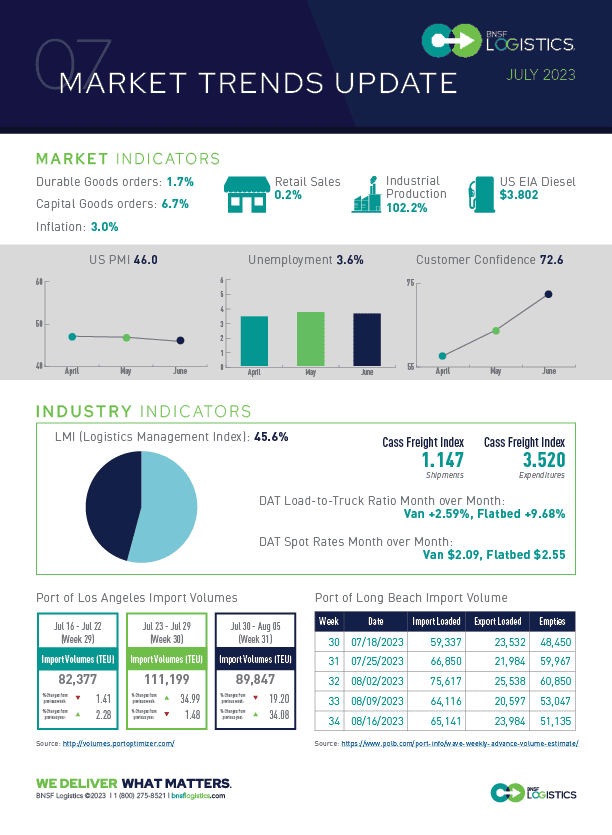Robert Sutton, Executive Vice President of Innovation at BNSF Logistics, reviews how month-over-month market and economic factors affect transportation and the supply chain.
INFLATION CONTINUES TO TREND DOWN, AND HOUSING COSTS CONTINUE TO BE A CHALLENGE
The US labor market showed new jobs created: 209,000 – down from a downward revised 309K increase in May and missing expectations of 240K – the slowest job growth rate since 2020.
· The unemployment rate fell slightly from 3.7% to 3.6%
· Hourly pay was up 0.4% in June, leaving the annual gain at 4.4%
· Labor participation was flat at 62.6%
· Largest gains were government (60K), healthcare, and private education
Housing costs continue to be a significant challenge and rose again in June, but Inflation continues to trend down, but not likely enough as the Fed looks to get the core rate down.
· Headline CPI rose 0.2% in June – up from May increase but below 0.3% expectations
· Consumer confidence increased in June from 102.5 to 109.7
Retail sales in June rose by 0.2%, much lower than the 0.5% forecast – much of the shortfall came from declining sales at gas stations.
· Sales at restaurants and bars rose a respectable 0.4%
· Real sales were flat sequentially.
New home starts dropped by 8% in June to 1.43 million annual pace. This is down from May’s pace of 1.56 million.
· Single-family construction dropped by 7%, while multi-family fell by 11.6%
· Building permits for new homes fell by 3.7% to an annual rate of 1.44 million units
New orders rose in May by 1.7% for 3rd straight month of increase and were boosted by demand for aircraft and vehicles. Net of transportation orders activity was a more modest 0.6% increase.
· Business investment slowed to a 0.7% increase
· Industrial production fell again in June by 0.5%
· The indices for mining fell by 0.2%
· Utilities dropped by 2.6%.
· Capacity utilization dropped from 79.4% in May to 78.9% in June
LMI INDEX SLIPPED FURTHER INTO CONTRACTION TERRITORY, AND THE FREIGHT RECESSION CONTINUES
June Manufacturing PMI® fell further into contraction territory dropping from 46.9 to 46.0 for the eighth consecutive monthly decline.
· Demand fell, with New Orders contracting, New Export Orders rising, falling back into contraction territory, Customers’ Inventories now contracting, and Backlog of Orders improving but still deep into contraction.
· Output/Consumption (Production and Employment) was negative with a combined 7.7-percentage point impact on the PMI®.
· Employment fell into contraction.
The freight recession continues and is likely to continue until retailers feel more confident and see increases in consumer buying activity.
· The LMI index slipped into contraction in June with a reading of 45.6, down from 47.3 in May, marking the 2nd month in a row of contraction.
· Inventory Levels dropped further into contraction territory at 42.9
· Transportation Capacity was 71.2 – up 1.9 points from May
· Transportation Utilization increased slightly from 45.5 to 46.8, showing utilization is still contracting but at a slower pace
· Inventory Levels dropped further into contraction territory at 42.9
Inventory Costs continued dropping to 57.1. Future index shows prices continuing to expand but with a reading up 6.9 points to 61.3. Warehousing Capacity continues to loosen up with a reading of 63.5. Warehousing Prices were up slightly at 63.6 but down considerably from rates last year as capacity loosens. Future index was 60.9 (up 0.4 points), showing an expectation for continued price increases but at a similar pace to the previous month.
The shipments component of the Cass Freight Index® fell 1.9% m/m in June on a seasonally adjusted basis. On a y/y basis, the index was 4.7% lower in June after a 5.6% decline in May.
· The expenditures component, which measures the total amount spent on freight, fell 2.6% m/m and 24.5% y/y in June
· Inferred Freight Rates decreased 0.9% m/m
Preliminary Class 8 net orders for June were 13,800, basically flat from May and down 7% year over year. Expectations have been for orders to drop below 10K units for some time, but that has yet to happen, suggesting fleets are still looking for equipment.

